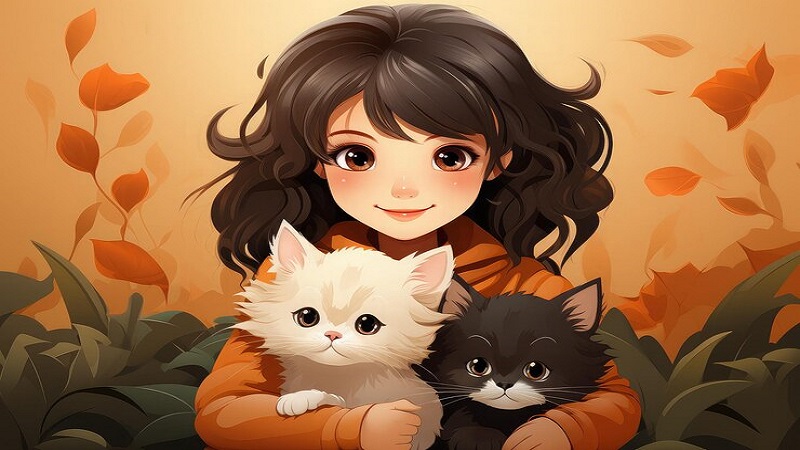The Magic of Cute Art has a unique way of tugging at our heartstrings and making us smile. Whether it’s a whimsical illustration, an adorable cartoon character, or a charming piece of digital art, cuteness has a universal appeal that resonates across cultures and ages. In this article, we’ll dive into what makes art “cute,” why it’s so endearing, and how it has become a powerful tool in various fields, from marketing to therapy.
What Defines Cute Art?
The Psychology Behind Cuteness
The Magic of Cute Art cuteness often invokes feelings of warmth and protectiveness. According to psychologists, features like large eyes, round faces, and small bodies trigger our nurturing instincts. This response is deeply rooted in evolutionary biology, where such traits are associated with infants, making us instinctively drawn to them.
1.2 Key Elements of Cute Art
Cute art typically includes:
- Exaggerated Features: Large, expressive eyes and small, rounded bodies.
- Bright Colors: Soft pastels or vibrant hues that enhance the feeling of joy.
- Playful Imagery: Fun, imaginative characters or scenes that evoke happiness.
The History of Cute Art
Origins of Cuteness in Art
The concept of cuteness in art has historical roots, from ancient sculptures of deities with exaggerated features to medieval illustrations of fantastical creatures. However, the modern phenomenon of cute art began gaining prominence in the 20th century with the rise of animation and comic books.
The Rise of Kawaii Culture
In Japan, the term “kawaii” (cute) became popular in the 1970s. This culture significantly influenced global art trends, leading to the widespread adoption of cute aesthetics in various forms of media and design.
The Influence of Cute Art on Pop Culture
Cute Art in Media and Entertainment
From Disney characters to popular anime, cute art has made a significant impact on media and entertainment. Characters like Mickey Mouse, Pikachu, and Hello Kitty have become cultural icons, showcasing the widespread appeal of cute art.
Marketing and Branding Strategies
The Magic of Cute Art businesses have recognized the power of cute art in attracting customers. Brands use adorable mascots and charming visuals to create emotional connections with their audience, making their products more memorable and appealing.
Cute Art in Digital Spaces
The Role of Social Media
Social media platforms are flooded with cute art, from memes and stickers to fan art and illustrations. These platforms amplify the reach of cute art, allowing it to spread quickly and engage a global audience.
Cute Art in Gaming
Video games often incorporate cute art to create a friendly and approachable atmosphere. Games like “Animal Crossing” and “Stardew Valley” use charming characters and settings to enhance the player experience and build a loyal fan base.
The Therapeutic Benefits of Cute Art
Reducing Stress and Anxiety
Studies have shown that looking at cute images can lower stress levels and improve mood. The soothing effects of cute art can be used in therapeutic settings to promote relaxation and emotional well-being.
Enhancing Child Development
For children, exposure to cute art can support cognitive and emotional development. It can encourage creativity, improve focus, and provide comfort in challenging situations.
Creating Your Own Cute Art
Tips for Beginners
The Magic of Cute Art If you’re interested in creating cute art, start with simple shapes and expressions. Focus on capturing the essence of cuteness through exaggerated features and bright colors.
Tools and Resources
There are numerous tools available for creating cute art, from digital drawing apps to traditional art supplies. Explore different mediums to find what works best for you and enhance your artistic skills.
Conclusion
The Magic of Cute Art continues to captivate and charm audiences worldwide. Its ability to evoke positive emotions, foster connections, and brighten our days makes it a beloved form of expression. Whether through media, marketing, or personal creativity, the influence of cute art is undeniable and enduring.Read More Infotimedod.
FAQs
1. What are the main characteristics of cute art?
Cute art typically features exaggerated facial expressions, rounded shapes, and vibrant colors to evoke feelings of joy and warmth.
2. How did kawaii culture influence global art trends?
Kawaii culture, originating in Japan, popularized the concept of cuteness in art and design, influencing global trends in media, branding, and digital spaces.
3. Can cute art be used in therapy?
Yes, cute art can be used in therapeutic settings to reduce stress, improve mood, and support emotional well-being.
4. What are some examples of cute art in popular media?
Iconic examples include Disney characters like Mickey Mouse, anime characters like Pikachu, and cultural icons like Hello Kitty.
5. How can I start creating my own cute art?
Begin by experimenting with simple shapes and expressions, using bright colors and focusing on capturing the essence of cuteness.
